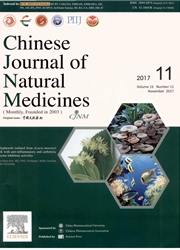

 中文摘要:
中文摘要:
Flavonoids are a large group of phenolic secondary metabolites havinga wide range of biochemical and pharmacological effects.Quantitative analysis of flavonoid profiles in the genus Actinidia,which has not been intensively conducted,is useful to a better understanding of the pattern and distribution of flavonoids.In the present work,a liquid chromatography-electrospray ionization-tandem mass spectrometry(LC-ESI-MS/MS)method was developed to profile the flavonoids,which was then used to determine the dynamic change of 17 biologically active flavonoids in the leaves of Actinidia valvata at the main growing stages,including glucuronides and acylated di-and triglycosides of flavonoids.The contents of flavonoid triglycosides were significantly higher than other flavonoids.The highest concentrations of kaemperol glycosides were observed in June,while other flavonoids showed highest concentrations in October.On the other hand,the contents of four isorhamnetin glycosides were increased sharply in September to October.The flavonoid profiles seem to be related to temperature,UV-B,and water deficit.Further studies are required to examine the functions of flavonoids in the Actinidia valvata and the underlying molecular mechanisms of actions.
 英文摘要:
英文摘要:
Flavonoids are a large group of phenolic secondary metabolites havinga wide range of biochemical and pharmacological effects. Quantitative analysis of flavonoid profiles in the genus Actinidia, which has not been intensively conducted, is useful to a better understanding of the pattern and distribution of flavonoids. In the present work, a liquid chromatography-electrospray ionization-tandem mass spectrometry (LC-ESI-MS/MS) method was developed to profile the flavonoids, which was then used to determine the dynamic change of 17 biologically active flavonoids in the leaves of Actinidia valvata at the main growing stages, including glucuronides and acylated di- and triglycosides of flavonoids. The contents of flavonoid triglycosides were significantly higher than other flavonoids. The highest concentrations of kaemperol glycosides were observed in June, while other flavonoids showed highest concentrations in October. On the other hand, the contents of four isorhamnetin glycosides were increased sharply in September to October. The flavonoid profiles seem to be related to temperature, UV-B, and water deficit. Further studies are required to examine the functions of flavonoids in the Actinidia valvata and the underlying molecular mechanisms of actions.
 同期刊论文项目
同期刊论文项目
 同项目期刊论文
同项目期刊论文
 Total Saponin fromRoot of Actinidia valvata Dunn Inhibits Hepatoma 22 Growth andMetastasis In Vivo b
Total Saponin fromRoot of Actinidia valvata Dunn Inhibits Hepatoma 22 Growth andMetastasis In Vivo b Combined application of macroporous resin and high speed counter-current chromatography for preparat
Combined application of macroporous resin and high speed counter-current chromatography for preparat 期刊信息
期刊信息
